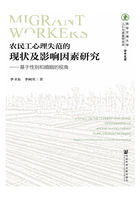
Abstract
The markedly difference social roles of male and female was commonly used to explain gender difference in psychological well-being and anomia, because social roles not only contain resources and powers, but also mean to undertake corresponding responsibilities and obligations. Although one of the most consistent findings in research on psychological well-being is that the traditional division of gender roles harm to female's psychological well-being, all the researches and findings are based on the western industrialized society and general population. The researches seldom pay attention to the gender difference in anomia among rural migrant worker in the context of social transition.
Although the“men outside and women inside”division of gender roles have formed the social structure which would be in favor of men, the traditional division of gender roles is gradually been eroding by the population migration in the context of social transition. With the rural female migrant moving to urban areas to seek work and getting one professional role, the roles gap between male and female is narrowed gradually. Meanwhile, unmarried men and unmarried women face different marriage market structure, because of the male surplus and female deficit in the context of gender imbalance. We introduce family structure, migration characteristic and marriage squeeze into stress process framework for analysis of gender difference of anomia among rural migrant worker under different marital status. For the married rural migrant worker, this study based on the coordination between social roles and sex roles, through analyzing the changes of social roles and family roles between both sexes and the stabilities of gender roles between both sexes to construct the gender difference framework among married rural migrant worker. For the unmarried rural migrant worker, we introduce marriage squeeze to assess the influences of gender imbalance on unmarried rural migrant worker. This developed framework not only can efficiently explain how population migration and gender imbalance influence on the gender equality relationship, but also make up the lack of framework to analyze a certain population, and provide a new way of explain the gender difference of anomia among rural migrant worker.
Based on the framework, using the date from the survey“Rural-Urban Migrants Study in X City, Fujian”, in early November 2009, this study investigate the current status, determinants of gender difference in anomia among rural migrant workers from the perspective of social roles and marriage squeeze. The main contributions of this study are the following.
There is gender difference in anomia among rural migrant worker and the marital status and marriage squeeze are the main determinants on the effect of sex in anomia among rural migrant worker. The empirical results reveal that the male rural migrant workers have high level of anomia than female rural migrant workers. This difference is derived from the difference in marital status and marriage squeeze among rural migrant workers, unmarried status and marriage squeeze would significant increase the level of anomia among rural migrant workers. The results reveal that marriage squeeze is the main determinant factor of the gender difference in anomia rural migrant worker.
In order to explore the net influence of marital status and marriage squeeze on anomia among rural migrant worker, we investigate the determinants of married rural migrant workers and unmarried rural migrant workers respectively. The results show that there is no gender difference in anomia among married rural migrant workers, but there is gender difference in the determinants of anomia among rural migrant workers. Female is more vulnerable to interpersonal relationship and emotions, male is more vulnerable to financial difficulties. In a word, the change of social role and the stability of gender role are the main determinants of gender difference in anomia among rural married migrant workers in the context of population migration. However, there is gender difference in anomia among unmarried rural migrant workers, and there is gender difference in the determinants of anomia among unmarried rural migrant workers. The imbalance of marriage market is the main determinant of anomia among unmarried male migrant workers, and the quality of marriage market is the main determinant of anomia among unmarried female migrant workers.
In sum, as the important reflections of social transition, migration population and gender imbalance have made huge impact on anomia among migrant workers. The disharmony between role expectation and role practice is the important mechanism of anomia among migrant workers. From the perspective of marriage and gender to explore the mechanism of anomia among migrant workers is also benefit to understand the influence of social transition on migrant workers life chances.